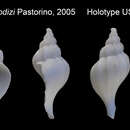en
names in breadcrumbs


“Trophon parodizi new species
(Figures 126-137, Table 1)
Description: Shell medium in size (up to 23 mm), very thin, chalky; protoconch smooth, of 1½ (1.41 × 1.39) very asymmetrical whorls; transition to teleoconch well defined; teleoconch of 4 convex whorls, spire less than ⅓ total shell height. Spire angle about 40º; suture impressed; aperture subovoid, interior glossy white; anterior siphonal canal medium in size (less than half height of aperture), narrow, open; umbilicus absent; outer lip rounded. Axial ornamentation of irregular, low, rounded ridges occupying entire whorl surface, numbering up to 9 in early whorls, but vanishing and undulate on last whorl. Spiral ornamentation poorly developed or almost smooth, when present consisting of obsolete, weak cords mostly developed on last whorl. Irregular growth lines present throughout shell.
Shell ultrastructure composed of two layers; innermost layer thin (35% of shell thickness), composed of colabrally aligned crossed lamellar aragonite, outer layer thick (65% of shell thickness) with amorphous calcite.
Operculum oval, with terminal nucleus. External surface covered by concentric, irregular, growth lines. Inner surface attachment area with two or three horseshoe-shape scars. Animal unknown.
Radula rachiglossan with rachidian teeth distinctive, central cusp thin, large; lateral cusps almost same size as central cusp, sharp denticle on upper third, irregular external denticles present. Base of rachidian tooth sinuous, sliding beneath base of next tooth. Marginal area with a conspicuous cusp. Lateral teeth with single, long cusps and narrow, slightly attached basal plate.
Type Material: Holotype and one paratype from 54°56° S, 65°03° W, Le Maire Strait, R/V ELTANIN Cruise 11, Sta. 969, 10 February 1964, 229-265 m, Blake trawl (USNM 896397) (Map 1).
Material Examined: Only holotype and paratype.
Distribution: Known only from the type locality.
Etymology: This species is named after Juan José Parodiz, one of the pioneers of malacology in Argentina, Curator Emeritus at the Carnegie Museum, Pittsburgh, and a good friend.
Remarks: Trophon parodizi is an unusual species within Trophon. The small, very thin shell, almost completely smooth and devoid of lamellae, is an exception for the Patagonian Trophon. However, the radula and protoconch match those typical of the genus. The radular morphology resembles that of T. plicatus where the denticles of the lateral cusp of the rachidian teeth are placed along the entire external edge of the lateral cusp. In T. parodizi the lateral cusp is thinner and the denticles are more clearly separated from it and placed mainly along the marginal area as in T. bahamondei. In addition-a character also present in T. bahamondei-most internal denticle lies against the lateral cusp and is clearly differentiated from the rest.”
Table 1. Measurements of the type specimen of Trophon parodizi new species in mm.
Species
Length
Width
Whorls
T. parodizi
Holotype
23
11
4
Paratype
21.1
10.6
4
(Pastorino, 2005: 76-78)
Trophon parodizi is a species of sea snail, a marine gastropod mollusk in the family Muricidae, the murex snails or rock snails.[2]
Can be found off of the southern coasts of South America.
Trophon parodizi is a species of sea snail, a marine gastropod mollusk in the family Muricidae, the murex snails or rock snails.